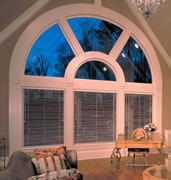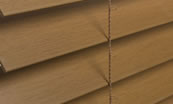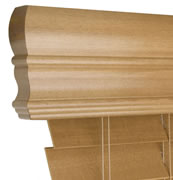The cord lock is the mechanism which locks the window covering in position when it is being raised or lowered.
Choosing the right window coverings is no easy task. At baby pawsblinds we understand the importance of the right window treatments for your home. Window shades and blinds can enhance the look of any room while providing a variety of other advantages such as UV protection and energy efficiency. To help you navigate our site we’ve put together these glossary terms so you can find the right window treatments for your home.
Arch Window
Arched windows are typically in the shape of a half-circle and often placed for decoration over a door or another window where they allow for additional light into a room. There are two ways to cover your arched windows:

Bathroom window treatments
Choosing the right blind or shade material for a bathroom window is an important decision, as the best window treatments for this environment are those that are moisture and heat resistant.

Bottom Rail
The bottom rail is the thicker piece of material at the bottom of the window covering that secures the ladders and cords to the bottom of the blind/shade. It is made of material which matches with the window covering ordered (e.g. wood, faux wood, metal).

Box Bracket
Box brackets are used to mount horizontal window blinds and shades. The box bracket mounts either to the inside or outside of the window frame. The window covering then slides into the mounted box bracket.
Braided Ladder
A braided ladder runs vertically down the window blind and holds the slats in place. The braided ladder, typically made of strong polyester, helps control the raising, lowering, and tilting of the blind.
Center Support Bracket
Center support brackets are used for horizontal window coverings which are too wide or heavy to be supported by only the two end brackets. This bracket helps support the weight of the window blind and prevents sagging.
Clearance
Clearance is the depth available for window coverings which are inside mounted. In general, window blinds require a greater clearance (since the slats require more depth) than window shades.
Cloth Tape
Cloth tape is a decorative piece of fabric, available in many colours and patterns, that is mounted over the ladders on horizontal window coverings. Cloth tapes increase privacy and light control by covering route holes, and help customize the look and style of your window covering.

Continuous Cord
A continuous cord loop opens and closes your window blind/shade evenly and smoothly. The cord is looped inside a cord tensioner which can be securely installed on the wall. This eliminates the dangling cord for a cleaner look and improved child safety. Operation is simple – just pull on the cord in one direction to raise the shade, and in the opposite direction to lower it. Continuous cord loops are also popular for extra-wide and heavier window coverings.

Control Length
The length of the tilt and lift controls is called the control length. Control length is typically half the length of the window covering.
Cord Lock
The cord lock is the mechanism which locks the window covering in position when it is being raised or lowered.
Cord Tilt
Window blinds with a cord tilt allow you to tilt the slats open or closed by pulling on the cord tilt control.

End Cap
End caps cover the ends of both the head rail and bottom rail. End caps are colour coordinated so as to match the colour of the window treatment.
Extension Brackets
Extension brackets are used when your window frame extends too far out for the standard outside mount brackets to fit. L-shaped extension brackets provide extra depth and clearance so your window coverings fit perfectly.
Fully Recessed
Fully recessed means that the window covering is inside mounted and fits neatly within the window frame, without protruding into the room.
The head rail is located at the top of the window covering, and it has 2 primary purposes.
1. Mounting:
2. Operation:

Hold Down Brackets
Hold down brackets hold the bottom rail in place to prevent the window covering from swaying or swinging. Hold down brackets are often used for window coverings that are outside mounted, window coverings that tilt open rather than being raised/lowered, and for door blinds so that you can open/close the door without having the window covering swing from the door.
Inside Mount
Inside mount means the window covering is mounted inside the window frame.

L-brackets are used when your window frame extends too far out for the standard outside mount brackets to fit. L-brackets provide extra depth and clearance so your window coverings fit perfectly.
Ladder Grommets
Ladder grommets are metal clips that are compressed on the ends of horizontal window covering ladders. Ladder grommets are attached to the bottom rail, and are used to level the window covering and secure the ladders.
Lift Cord
The lift cord control is located on one side of the window covering and allows you to raise and lower the blind/shade.

The loop ladder is the braided ladder used in wood and faux wood blinds that have the routeless or No-Holes privacy option. Each ladder has loops on the front and back through which the cord is laced, allowing you to raise and lower the blinds.
Multiple blinds or shades on one headrail
2 or 3 window coverings can be mounted on a single head rail. This is a great option if you have an extra-wide window and you want to keep the window coverings lightweight. Each blind/shade will work independently, but you’ll have a unified, streamlined look with a shared head rail.

No Holes Privacy
The no holes privacy option eliminates those tiny route holes in standard window coverings. This gets rid of the pinpricks of light that come through, giving you more light and privacy control. Instead of the corded ladders running through the middle of the slat, there are notches on the back of the slat where the cords run through. You still get the same functionality, but you will have a more streamlined look.

Outside Mount means the window covering is mounted on the outside the window frame.

Projection
Projection is the distance between the wall and the front of the mounting bracket. This determines whether the window covering will clear the window frame.
Return
With blinds that are outside mounted, there is a gap on the sides which makes the ends of the headrail visible. The return covers that gap, and matches perfectly, by attaching to the side of the valance.

Return L Bracket
The return L bracket (typically metal or plastic) is used for mounting the returns to the face of the valance.
The roman fold refers to the fold used for roman and woven wood shades. When these shades are raised, they fold in an accordion-like fashion from the bottom as they move their way up.
Route holes are the tiny holes in the slats of horizontal blinds that attach the lift cord to the window blind.

Routeless
When lift cords are attached through route holes in a horizontal blind, it allows tiny pinpoints of light to filter into the room. The routeless or No Holes Privacy feature eliminates these pinpoints of light. So if you prefer greater light blockage, this is the right feature for you. With the routeless option, the lift cords are attached to a notch in each slat instead of through route holes. Another advantage of the routeless features is that you can remove each slat individually as needed for cleaning.

Stop Ball
The stop ball collects all lift cords together at the point from which they come out of the head rail. This prevents the cords from tangling and helps them operate smoothly when raising or lowering the window covering.
Tassel
The tassel is a decorative piece that attaches to the ends of lift and tilt cords and is colour coordinated with the window covering.

Valance
The valance is a decorative piece at the top of the window covering that covers the head rail.

Valance clips allow you to attach the valance to the head rail (if it was not already attached at the factory).
Wand Tilter
The wand tilter is located on one side of your window blind and is used to tilt the slats open or closed. When turned in one direction, the slats open. And when turned in the opposite direction, the slats close.

We noticed you're visiting from Latvia. We've updated our prices to Euro for your shopping convenience. Use Canadian dollar instead. Dismiss